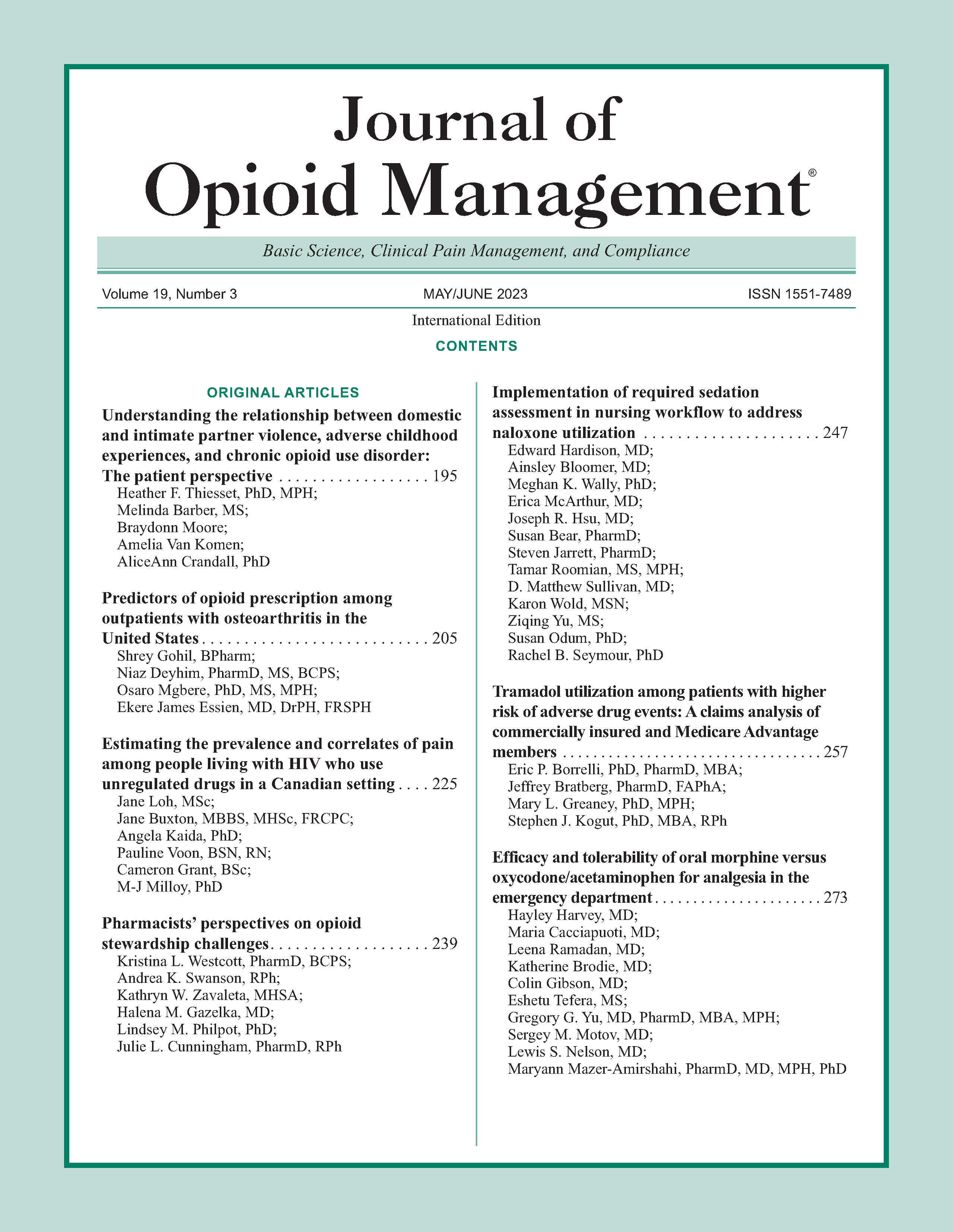Implementation of required sedation assessment in nursing workflow to address naloxone utilization
DOI:
https://doi.org/10.5055/jom.2023.0780Keywords:
opioid oversedation, naloxone administration, electronic clinical decision support, patient safetyAbstract
Objective: Opioid-related adverse drug events continue to occur. This study aimed to characterize the patient population receiving naloxone to inform future intervention efforts.
Design: We describe a case series of patients who received naloxone in the hospital during a 16-week time frame in 2016. Data were collected on other administered medications, reason for admission to the hospital, pre-existing diagnoses, comorbidities, and demographics.
Setting: Twelve hospitals within a large healthcare system.
Patients: 46,952 patients were admitted during the study period. 31.01 percent (n = 14,558) of patients received opioids, of which 158 received naloxone.
Intervention: Administration of naloxone.
Main outcome of interest: Sedation assessment via Pasero Opioid-Induced Sedation Scale (POSS), administration of sedating medications.
Results: POSS score was documented prior to opioid administration in 93 (58.9 percent) patients. Less than half of patients had a POSS documented prior to naloxone administration with 36.8 percent documented 4 hours prior. 58.2 percent of patients received multimodal pain therapy with other nonopioid medications. Most patients received more than one sedating medication concurrently (n = 142, 89.9 percent).
Conclusions: Our findings highlight areas for intervention to prevent opioid oversedation. Investing in electronic clinical decision support mechanisms, such as sedation assessment, could detect patients at risk for oversedation and ultimately prevent the need for naloxone. Coordinated order sets for pain management can reduce the percentage of patients receiving multiple sedating medications and promote the use of multimodal pain management in efforts to reduce opioid reliance while optimizing pain control.
References
Commission TJ: Safe use of opioids in hospitals. Sentinel Event Alert. 2012; 49: 1-5.
Pasero C: Assessment of sedation during opioid administration for pain management. J Perianesth Nurs. 2009; 24(3): 186-190.
Jungquist CR, Willens JS, Dunwoody DR, et al.: Monitoring for opioid-induced advancing sedation and respiratory depression: ASPMN membership survey of current practice. Pain Manag Nurs. 2014; 15(3): 682-693.
Neil K, Marcil A, Kosar L, et al.: Retrospective analysis of opioid medication incidents requiring administration of naloxone. Can J Hosp Pharm. 2013; 66(5): 280-288.
Pawasauskas J, Stevens B, Youssef R, et al.: Predictors of naloxone use for respiratory depression and over-sedation in hospitalized adults. Am J Health Syst Pharm. 2014; 71(9): 746-750.
Jarzyna D, Jungquist CR, Pasero C, et al.: American society for pain management nursing guidelines on monitoring for opioid-induced sedation and respiratory depression. Pain Manag Nurs. 2011; 12(3): 118-145.
Charlson M, Pompei P, Alex K, et al.: A new method of classifying prognostic comorbidity in longitudinal studies: Development and validation. J Chron Dis. 1987; 40(5): 373-383.
Flegal K, Carroll M, Kuczmarski R, et al.: Overweight and obesity in the United States: Prevalence and trends, 1960-1994. Int J Obes. 1998; 22(1): 39-47.
Harris P, Taylor R, Thielke R, et al.: Research electronic data capture (REDCap)—A metadata-driven methodology and workflow process for providing translational research informatics support. J Biomed Inform. 2009; 42(2): 377-381.
Centers for Disease Control and Prevention: Defining adult overweight and obesity. 2017. Available at https://www.cdc.gov/obesity/basics/adult-defining.html. Accessed June 1, 2020.
Dowell D, Haegerich T, Chou R: CDC guideline for prescribing opioids for chronic pain—United States, 2016. MMWR Recomm Rep. 2016; 65(No. RR-1): 1-49.
United States Census Bureau: Age and sex composition. 2010. Available at http://www.census.gov. Accessed June 1, 2020.
Drager L, Togeiro SP, Lorenzi-Filho G: Obstructive sleep apnea: A cardiometabollic risk in obesity and the metabolic syndrome. J Am Coll Cardiol. 2013; 62(7): 569-576.
Punjabi N: The epidemiology of adult obstructive sleep apnea. Proc Am Thorac Soc. 2008; 5(2): 136-143.
Yue H, Guilleminault C: Opioid medication and sleep-disordered breathing. Med Clin North Am. 2010; 94: 435-446.
US Department of Veterans Affairs: VA/DoD Clinical Practice Guidelines: Management of Opioid Therapy (OT) for Chronic Pain. Washington, DC: US Department of Veterans Affairs, 2010.
Dasgupta N, Funk M, Proescholdbell S, et al.: Cohort study of the impact of highdose opioid analgesics on overdose mortality. Pain Med. 2016; 17(1): 85-98.
Jones C, McAninch J: Emergency department visits and overdose deaths from combined use of opioids and benzodiazepines. Am J Prev Med. 2015; 49: 493-501.
Gomes T, Mamdani M, Dhalla I, et al.: Opioid dose and drug-related mortality in patients with nonmalignant pain. Arch Intern Med. 2011; 171: 686-691.
Kuip EJ, Zandvliet ML, Koolen SL, et al.: A review of factors explaining variability in fentanyl pharmacokinetics; focus on implications for cancer patients. Br J Clin Pharmacol. 2017; 83(2): 294-313. DOI: 10.1111/bcp.13129.
Grissinger M: Keeping patients safe from methadone overdoses. P T. 2011; 36(8): 462-466.
Fookes C: Drug half-life explained. Available at https://www.drugs.com/article/drug-half-life.html. Accessed July 26, 2021.
Yung L, Lee K, Hsu C, et al.: Patterns of naloxone use in hospitalized patients. Postgrad Med. 2017; 129(1): 40-45.
The Joint Commission: Facts about joint commission accreditation standards for health care organizations: Pain assessment and management. 2018. Available at https://www.jointcommission.org/facts_about_joint_commission_accreditation_standards_for_health_care_organizations_pain_assessment_and_management/. Accessed March 19, 2018.
Published
How to Cite
Issue
Section
License
Copyright 2005-2025, Weston Medical Publishing, LLC and Journal of Opioid Management. All Rights Reserved.











